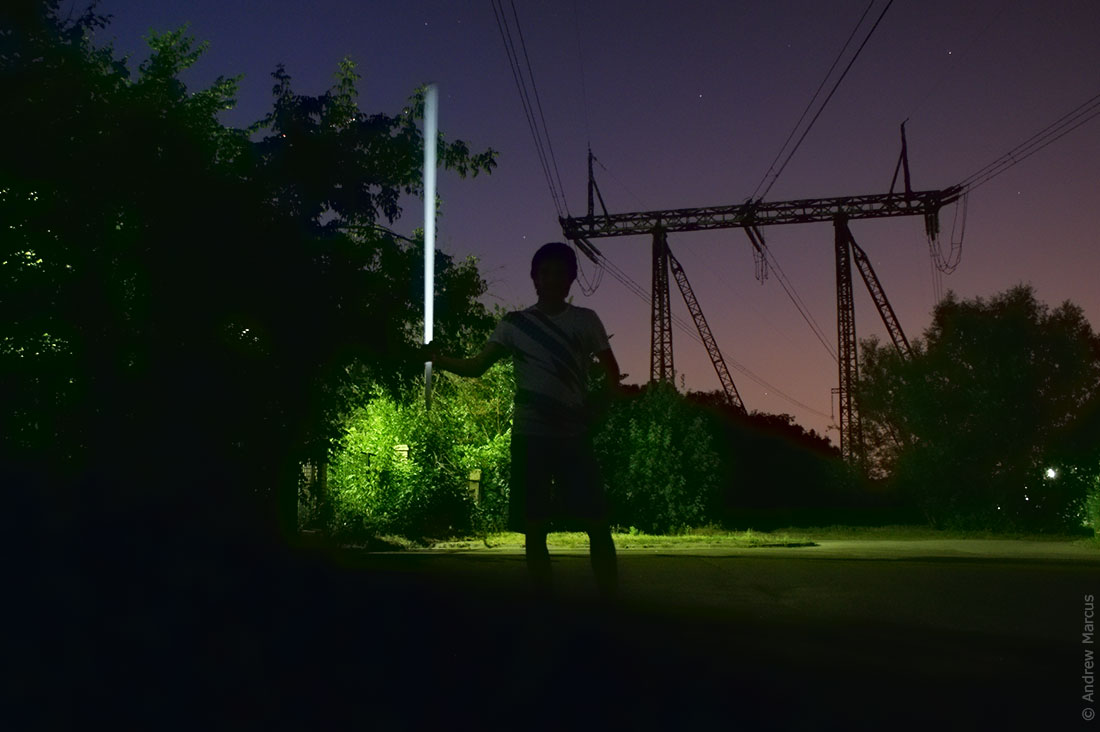Lamp glowing under the power line
In the suburban city of Krasnogorsk, there is a section of a high-voltage 500-kilovolt power transmission line where the wires sag significantly. They sag so much that it’s simply terrifying to walk under them: the distance from the ground is only about 5 meters. When riding a bicycle, you get a strong electric shock from the handlebars, and only a crazy person would dare to walk with an umbrella in those areas during rain. Moreover, the wires are not located in an empty area, but right in a residential zone. There are houses and a hospital nearby.
But the focus of this article will not be on sanitary norms, but on physics. The thing is, the power transmission line creates a rather strong electric field, which, in combination with low-hanging wires, can produce an interesting effect.

This is a fluorescent lamp that lights up without any wires or other contrivances under the power transmission line. The lamp is quite ordinary, exactly the same as those used for lighting in offices. The only difference is that it’s slightly longer — one and a half meters instead of 75 centimeters. The lamp not only lights up on the ground but also in the air and even when held in hands.

Why does the lamp light up? It’s because of the voltage at its ends, which in turn arises from the electromagnetic field created by the power transmission line. The electrostatic potential on the wires is very high, while the potential on the ground is known to be zero. In other words, there is a potential difference or voltage between the wires and the ground. And there is also a potential difference at the ends of the lamp because one end of the vertically positioned lamp is always closer to the wires, while the other end is either farther from them or on the ground. However, this potential difference is still small enough not to produce a current strong enough to pose a danger to humans. And since the current is weak, it should not light up the lamp either. Additionally, fluorescent lamps are not designed so simply: they have special starters inside that ignite them in a specific way. So why does the lamp light up? It’s because such lamps essentially light up for different reasons. Instead of a glowing tungsten arc inside the glass tube, there are mercury vapor pairs that create ultraviolet radiation (converted into visible light by a white phosphor on the glass) due to the voltage, but not at the ends of the lamp, but throughout its entire length, including the contacts and the mercury itself. The field under the power transmission line creates a potential difference in the mercury vapor pairs inside the lamp, causing them to emit light. That’s why a starter is not needed for it to glow, regular incandescent bulbs do not light up under the power transmission line, and an electric shock doesn’t kill a person. The observed effect is based on a somewhat different nature.

The lamp lights up very brightly if plugged into the ground, slightly less brightly when held vertically in hands, and even less brightly when held horizontally. The reason lies in the different voltage across the lamp: the end inserted into the ground provides an instantaneous path for current discharge, while the vertical position creates a greater potential difference due to the varying distance from the ends of the lamp to the wires.

Moreover, it can be observed that if one holds the lamp by its middle with both hands, the glow ceases to be uniform. It dims completely in the space between the hands and also significantly diminishes on the segment from the hand to the lower end, provided that this segment is not too long. The lamp does not light up between the hands because the potential difference at that point is too small to ignite the mercury vapor pairs: the potential from the ends of the lamp passes through it and drains through the hands into the ground, and the voltage between them is simply insufficient.

Similarly, a lamp taken with its free lower end behaves in the same way.

In addition, the glow of the lamp sharply diminishes when brought close to massive iron structures or wide bushes. Presumably, these objects also contribute to the dissipation of potential into the ground, “drawing” the field around them. I also suggest taking a look at a video lecture where a similar experiment is conducted with a Van de Graaff generator.
